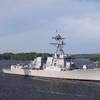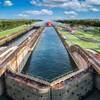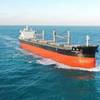Faster and cheaper and more efficient. Nearly everyone agrees that the rapid change from break-bulk cargo handling to the containership has been revolutionary. It is perhaps the most startling development since the shift from sail to steam. In the world of shipping, the change has been so profound that we can readily refer to it as paradigm shift.
How do we explain the change? Professional historians are often reluctant to attribute major cultural changes to a single individual. Many factors, large and small, play into the making of any major change so that historians typically try to avoid "the great man" explanation.
For example, the American Merchant Seamen's Manual (Sixth Edition,) edited by William B. Hayler, carefully avoids attributing the development of the containership to a single individual. This account takes note of the military developments in World War II. To be sure, U.S. military planners did experiment with some odd-sized container boxes as well as ammunition boxes, but most of the cargo was still handled in the old-fashioned piece-by-piece method. The book then goes on to say, "A few United States companies began to standardize the size of their containers and build or convert ships for carrying them." This is a customary way of rendering a historical account. It sounds as if the containership somehow just happened as a result of inevitable historical forces.
What's missing in this account? Most industry observers would agree that the account overlooks the specific contributions of one man - Malcolm McLean. This is one of those instances where it is reasonably clear that one man made a big difference. The story by now has been told so often that it is practically an industry legend.
Oliver E. Allen gives one of the best accounts in the article, The Man Who Put Boxes on Ships, which appeared in American Heritage Magazine. It seems that in 1934, McLean founded McLean Trucking Company, which was headquartered in North Carolina. The initial idea for containerization occurred to McLean one day in 1937 on a pier in Hoboken, N.J.
"I had driven my trailer truck up from Fayetteville, N.C.," McLean told Allen, "with a load of cotton bales that were to go on an American export ship tied up at the dock. For one reason or another I had to wait most of the day to deliver the bales, and as I sat there, I watched all those people muscling each crate and bundle off the trucks and into the slings that would lift them into the hold of the ship. Onboard the ship every sling would have to be unloaded by the stevedores and its contents put in the proper place in the hold. What a waste in time and money. Suddenly the thought occurred to me: Wouldn't it be great if my trailer could simply be lifted up and placed on the ship without its contents being touched? If you want to know that's when the seed was planted."
So the seed of the idea was planted in the late 1930's, but it would take nearly twenty years for the plant to bear fruit. An excellent account of this next phase of development is given by Luc Cuyvers in his book, Sea Power, the companion volume to the Public Television Series. Cuyvers argues that McLean's contribution was the realization that "most break-bulk cargo could and should be moved in containers." Not just a box here and there, but also nearly everything should be moved this way. McLean's next contribution was the idea "that the containers should be standardized, so that they would fit on any truck or train anywhere in the world." Not only would this idea speed-up handling; it would also reduce pilferage.
So McLean had some fine ideas, but he did not just stop there. He backed his ideas with money and action: in 1995 he purchased the Pan Atlantic Steamship Corporation, which had thirty-seven vessels. Then he proceeded to alter six of them to carry containers on deck. He called the first of these, a converted World War II tanker, Ideal X, which sailed on April 26, 1956, from Port Newark to Houston with 58 containers secured on deck. The containers, which measured 33 ft. x 8 sq. ft. (10 m x 2.4 sq. m)could readily be transferred from the road to the deck of the ship. McLean called the voyage an "experiment in integrated truck-ship freight distribution." Almost unnoticed at the time, we now look back on this voyage as one of tremendous historic significance.
The subsequent story is well told by Richard Woodman in his authoritative, The History of the Ship. By 1961 McLean converted some more standard World War II vessels to carry shipping containers to Puerto Rico. He changed the name of his company to Sea-Land Service Incorporated. By then others had already copied his idea. It was on August 31, 1958 that the Matson Line sent its Hawaiian Merchant from San Francisco bound for Honolulu, with 75 containers on its deck, each measuring 24 x 8.5x 8ft. (7.3 x 2.5 x 2.4m).
In the 1960's both Sea-Land and Matson began improving their port facilities by installing special gantry cranes for rapid and efficient shore-based handling of containers. Soon, it was no longer necessary to put cranes aboard ship. Today, one man operating a gantry can typically handle about 30 containers per hour, loading containers within the guides that are built into the containership.
Gradually, the sectional dimensions became standardized thanks to U.S. trucking regulations. Most boxes were 8 x 8.5 ft. (2.4 x 2.5 m), with varying lengths of 10, 20, 30, and 40 ft. In time, the industry came up with a common denominator, the TEU, or "twenty-feet equivalent unit," a term invented by Richard Gibney.
Containers had the additional advantage of great efficiency with their low tare weight of about 2.3 tons for a standard TEU. This box typically could load nearly 22 tons of payload. Early Panamax ships carried containers an impressive twelve deep, placing them 10 wide across the holds and 13 across the decks.
Launched in America, containershipping soon spread all over the world. In Europe, the German concern of Hapag-Lloyd and the Danish firm Maersk took leadership roles. Several old British firms merged to form Overseas Container Limited (OCL.) The first OCL ships started operating in the late 1960's , and they were named after bays. For example, both the Botany Bay and Moreton Bay grossed 27,000 tons and steamed routinely at 22 knots.
At one point, Sea-Land experimented with a new class of containerships, the SL7s, which were capable of very high speeds of up to 33 knots. At first, this high speed seemed to be a tremendous competitive advantage. But later, with the oil crisis and the high price of fuel, these expensive SL7s were retired from service.
In time Malcolm McLean left Sea-Land, and he took over United States Line, the flagship company of the American merchant marine. McLean came up with the idea of building a dozen "Econoships," which were very big with enormous carrying capacity. They weighed nearly 59,000 tons and they could carry 4,480 TEUs at a speed of only 18 knots. The ships were built by Daewoo in South Korea. Delivered in 1984-1985, they were named after American states like American California and American Alabama. It was a clever idea in theory, but it did not work out in practice. The ships were too slow, and the United States Line went bankrupt.
From this hard-won lesson, most of the next generation of containerships operated by big companies like Maersk and Evergreen settled on ships of Panamax dimensions with normal service speeds of about 23 knots. In the 1990's containerships have gotten bigger and bigger. For example, Regina owned by the Maersk Line, was built in Denmark in 1996 and was designed to carry 6,000 TEUs, spanning 17 containers across the deck. It is considered an ultra-large container vessel (ULCV). Contrast this capacity with Malcolm McLean's Ideal X that carried only 58 containers. It is a stunning increase from a few dozen to thousands of containers. One of the world's largest ships, Regina is 80 ft. (24.3 m) longer than the cruise ship Queen Elizabeth 2. With a length of 1,043 ft. (318 m), Regina could easily carry three football fields placed end-to-end and still have room to spare. Or put another way, the ship is longer than the Eiffel Tower (990 ft.) is tall.
When Regina visited the Port of New York and New Jersey on July 22, 1998, it created quite a stir because it had to carry less than its maximum capacity so it would not run aground. The message was clear: deeper and wider channels would be needed to accommodate a fully-loaded Regina.
And this is not the end of the story. The ships just keep getting bigger. Launched in 1998 was the Sovereign Maersk at 1,138 ft. (347 m), 95 ft. (29 m) longer than Regina Maersk. The Sovereign is able to carry 6,600 TEUs, a 10 percent increase.
Where will it all end? Could we some day be looking at 10,000 TEU vessels? It's possible if we can keep up with the necessary dredging. We would need very deep and wide channels to provide the necessary turning radius. In addition, we would need more cranes with a greater outreach since the new ships are 17 containers wide. Few cranes today can reach that far.
Today, Malcolm McLean is heading up a new company, Trailer Bridge, in Jacksonville, Fla., which he started in 1992 as the world's first company to build vessels exclusively for 53-ft. (16.1 m) containers. Trailer Bridge is a motor carrier providing truckload service between the U.S. and Puerto Rico with domestic service covering the Eastern half of the U.S. With two sailings a week, Trailer Bridge provides safe and efficient freight transportation between the U.S. mainland and Puerto Rico. Meanwhile McLean can now look back on a long and productive career with satisfaction. It is likely that the history books of tomorrow will honor him along with Henry Ford, Thomas Edison, and the Wright Brothers.
Did McLean "invent" the containership? Not exactly, since most of the pieces of the puzzle were already out there waiting to be put together. McLean was operating in the classic American role of the "tinkerer," a person who enjoys repairing and experimenting with machinery. Thus, McLean was very much like Ford, Edison, and the Wrights. So we can reasonably say that if McLean did not invent the containership, he certainly is the man who made it happen.
Back in the 1930's no one would have predicted that a North Carolina truck operator would become a giant in the maritime industry, but history will long remember McLean. He was recognized on May 12, 1999 by the Maritime Association of the Port of New York and New Jersey as "The Man of the Century," and Forbes Magazine described him as "one of the few men who changed the world."
Sponsored Content
Safer Starts Here: Build Ships, Protect Crews

Featured videos

“One Man, One Wrench” Launched a Global Maritime Power Play

Cat Pushes Forward on Hybrid Electric Solutions, Alternative Fuels

Corn Belt Ports Streamlines Critical Agriculture River Shipments
July 2025
 Read the Magazine
Read the Magazine

 Read the Magazine
Read the Magazine
This issue sponsored by:

The Golden Ticket – VIP access & invitation to take an active role in History
Subscribe for
Maritime Reporter E-News
Maritime Reporter E-News is the maritime industry's largest circulation and most authoritative ENews Service, delivered to your Email five times per week







